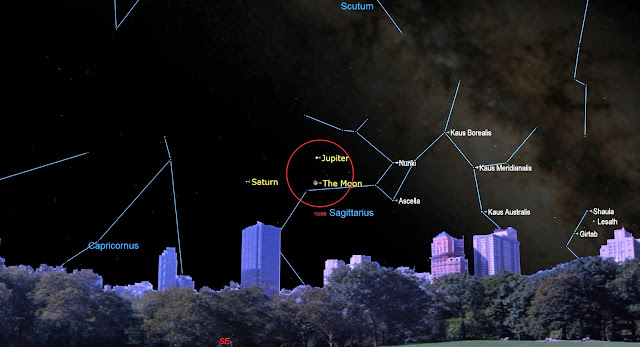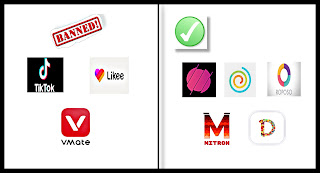What are the Astronomical Events waiting for you in August 2020?
Stargazing Events of August 2020
With
the appearance of Comet NEOWISE, July was the best month loaded with many
astronomical events for stargazing.
However
August is no less than July with its perfect stargazing weather and dark skies.
If you also missed to spot the NEOWISE like me, you will get many other chances
in this month.
Although I should have posted this article before starting this month, but it’s not that late to watch the remaining events in the early August.
So, check out these
space events of August 2020 and let me know in the comment section, 'which one is the most curious event you are waiting to see?'.
Also read: Who will be the first Woman on Moon?
August 1-Triangle of
Moon, Jupiter, and Saturn
 |
| Image Courtesy of Starry Night Education |
On August 1st, the Moon made a lovely triangle with Jupiter and Saturn low in the southeast after sunset. The trio was visible all night, rising to its highest point in the south.
If you did miss them, there's another chance at the end of the month, on
August 28th, as the Moon swings back around in its orbit to join the planetary
pair.
August 3-Full green corn Moon
 |
| Image Courtesy of Starry Night Education |
The August full moon, also known as the "Sturgeon Moon", "Red Moon", "Green Corn Moon", and "Grain Moon", was fully illuminated on August 3 because it was positioned opposite the sun in the sky, causing the moon to rise at sunset and set at sunrise.
August 4-Reiner Gamma
Lunar Swirl
The Reiner Gamma Lunar Swirl is a small, high-albedo area located just
inside the western edge of Procellarum.
The swirl has one of the strongest magnetic anomalies on the moon. At high magnification, its complex, swirling shape can be seen.
August 6-Comet
NEOWISE close to Messier
On Thursday Aug. 6, in the western sky after dusk, the path of fading
Comet (NEOWISE) carried it closely past the globular star clusters Messier 53
and NGC 5053.
 |
| Image Courtesy of Starry Night Education |
August 9-Waning Moon meets Mars
The waning gibbous moon will be positioned only two finger widths to the
lower right bright, reddish Mars before dawn on Aug. 9.
The conjunction between the moon and Mars will take place at 4am EDT, but the duo will be close to each other starting when Mars rises around 11pm.
August 12-Perseids
Meteor Shower
The Perseid meteors come from a comet called Swift-Tuttle, which orbits
the Sun every 133 years.
The spectacular Perseid meteor shower, which runs annually between July
17 and Aug. 26, will peak before dawn on Wednesday, Aug. 12 and will be no
different this year.It delivers up to 100 meteors per hour at the peak.
 |
| Image Courtesy of Starry Night Education |
So, are you excited for the ‘fireballs’?
August 13-Venus at
greatest western elongation
Venus is the brightest object we see everynight in sky, other than the
moon and the sun. On Thursday, Aug. 13, Venus will reach its highest separation,
46 degrees west of the sun, for its morning appearance.
August 14-Ganymede’s
Shadow and the Great Red Cross Jupitar
At 10:30 pm EDT on Aug. 14, observers in the Central Time zone, and east of there, can watch both Ganymede's large shadow and the Great Red Spot travel across Jupiter's northern and southern hemispheres, respectively.
 |
| Image Courtesy of Starry Night Education |
August 15-Venus close
to crescent Moon
On August 15th, before dawn, Venus in the east will appear just a couple
of finger widths apart from the crescent Moon.
The duo will be seen surrounded by a ring of bright stars that morning
before getting bright.
August 15-Uranus
stands still
On Saturday, Aug. 15, the distant blue-green planet Uranus will cease
its eastward motion through the distant stars of southern Aries and commence a
retrograde loop that will last until January next year.
However, the planet is visible only through a pair of binoculars in the
dark sky.
August 22-Rare double shadow transit on Jupiter
 |
| Image Courtesy of Starry Night Education |
Amongst the four Galilean Moons, Lo and Ganymede will cast their shadows
on Jupiter on August 22. The pair will cross
Jupiter together for nearly two hours, until Lo's shadow moves off Jupiter.
August 28-Ceres at
its closest approach to Earth
On Aug. 28, the dwarf planet (formerly asteroid) Ceres will reach
opposition, its closest approach to Earth for the year.
August 29-Bright Moon
passes Saturn
The planet Saturn will appear near the waxing gibbous Moon, with the brighter planet Jupiter also appearing nearby on Aug. 29.
August 30-Sinus Iridum’s Gold
 |
| Image Courtesy of Starry Night Education |
On Sunday night, the terminator on the waxing gibbous moon will fall
just west of Sinus Iridum, the Bay of Rainbows.



August 12 I will be watching. Very nice article 👍 Love from Philadelphia
ReplyDeleteThank you, don't miss the fireballs show.
ReplyDeleteVery good informative content... Nice research. Keep it up
ReplyDelete